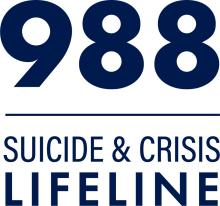Suicide Prevention
Suicide is a top 10 leading cause of death in Wisconsin. It is a serious public health issue whose effects are felt by family, friends, and communities throughout the state. Understanding the complexity of suicide is an important way to support people experiencing suicidal thoughts and behaviors, take part in suicide prevention, and change the conversation around suicide.
Need support now? Know someone who does?
Contact the 988 Suicide & Crisis Lifeline if you are experiencing distress or are worried about a family member or friend who may need support.
- Call or text 988
- Chat at 988lifeline.org
You will be connected with a trained counselor. This is a free service available 24/7. Your conversation is confidential unless there is imminent danger for you or others.
Learn what to expect when you contact the 988 Suicide & Crisis Lifeline.
Help for yourself
Anyone can experience difficult times. Learn what to do to get through these moments.
Help for someone else
Talking with someone who may have suicidal thoughts or behaviors can be difficult. Learn how you can be supportive and make a difference in their time of need.
Risk and protective factors
Risk factors are characteristics that make it more likely someone will die by suicide.
- Mental health conditions, particularly mood disorders, schizophrenia, anxiety disorders, and certain personality disorders
- Alcohol and other substance use disorders
- Hopelessness
- Impulsive and/or aggressive tendencies
- History of trauma or abuse
- Major physical illnesses
- Previous suicide attempt(s)
- Family history of suicide
- Job or financial loss
- Loss of relationship(s)
- Easy access to lethal means
- Local clusters of suicide
- Lack of social support and sense of isolation
- Stigma associated with asking for help
- Lack of health care, especially mental health and substance use treatment
- Cultural and religious beliefs, such as the belief that suicide is a noble resolution of a personal dilemma
- Exposure to others who have died by suicide (in real life or via the media and internet)
Someone who hurts themselves on purpose may or may not have the intention to die by suicide. See more information on self-harm and what people can do to help someone who is self-harming.
Protective factors are things that make it less likely someone will die by suicide.
- Effective coping and problem-solving skills
- Reasons for living such as family, friends, or pets
- A strong sense of cultural identity
- Support from a partner, family, and friends
- Feeling connected to others
- Feeling connected to school, community, or other social organizations
- Access to consistent and high quality physical and mental health care
- Safe storage of firearms and medications
Impact and response
Suicide prevention is best accomplished through comprehensive efforts that make use of data in conjunction with strategies designed to save lives.
Data
Suicide touches all communities—all genders, all age groups, and all races.
Strategies
Wisconsin uses a combination of efforts that work together to prevent suicide and build safer, more supportive communities.
Prevent Suicide Wisconsin
Prevent Suicide Wisconsin is a public-private partnership that was formed in 2009 when state agencies, county and municipal health departments, people with lived experience of suicide attempts and losses, and suicide prevention coalitions identified the need to create an organization for suicide prevention efforts in Wisconsin. The Prevent Suicide Wisconsin Steering Committee meets quarterly and provides oversight to Wisconsin's suicide prevention efforts.
Learn more about the work of Prevent Suicide Wisconsin.
Prevent Suicide Wisconsin's latest state suicide prevention plan was published in 2025. See Wisconsin's Suicide Prevention Plan: Strategies for Action and Hope (PDF).





